|
Examination of the Japanese urban form using front/back concept: a case study in Shibuya Commercial District
|
|
<Journal of Asian Architecture and Building Engineering, Sep 2021> |
| Dong, Jingyao, Yijun Zhu, Ryuzo Ohno |
This study attempts to interpret the urban form of the Japanese cities through the natural spatial reference of front and back which is deeply rooted in Japanese culture.
The aim is to provide workable guidance for interpreting the urban form, and for creating diverse and active commercial spaces in Japan and beyond. Based on the physical
built environment, this study proposes a parameter of interface which is defined by components taken from both surface of the building and the objects around. The interface
is categorized into four types by the combination of main-component of front (F)/back (B) and sub-component of front (f)/back (b), namely Ff, Fb, Bf, and Bb. The approach
is demonstrated in the typical commercial district of Shibuya, Tokyo. By analyzing the distributional features of the interface quantitatively, the scopes and attributes of
front and back-side space are figured out. According to the distributional similarity of the interface, we sort the urban space into front-side space defined by Ff and back-side
space defined by Fb, Bf, and Bb. Thereinto, the ambiguous back-side space defined by Fb and Bf supports diverse possibilities and highly involves in the everyday life of Japanese people.
Full paper ⇒ Online
|
|
|
Effect of pedestrian observation mode on perceptual continuity of the streetscape
|
|
<Proceedings of the 12th European Architectural Envisioning Association Conference, Envisioning Architecture:
Image, Perception, and Communication of Heritage, pp. 398-407, Sep. 2015>
|
| Ryuzo Ohno, Yang Yu |
The design guideline aims to preserve existing historical and cultural landscapes and to maintain a harmonious streetscape by regulating such physical features of the building façade as color and height within a certain range. These variables and acceptable range, however, have often decided arbitrarily without any scientific and empirical researches. There is another issue related to the way of examining streetscape. The conventional way of assessing streetscape is often made only by the appearance of building façade (elevation) viewed from a distance. In daily life, we appreciate the streetscape not only by this mode of observation but also by other modes. The physical feature of a street that influences streetscape may differ according to the observation mode. Therefore, it is necessary to clarified what are most influential variables for evaluation of the streetscape in a given observation mode of pedestrians.
The present study examines how those physical features of the buildings
and their layout can affect pedestrians’ evaluation of the streetscape
in terms of perceptual continuity in four observation modes:
1) stationary pedestrian’s view perpendicular toward the building façade,
2) stationary pedestrian’s view parallel with the building façade,
3) moving pedestrian’s view perpendicular toward the building façade, and
4) moving pedestrian’s view parallel with the building façade.
Full paper → PDF |
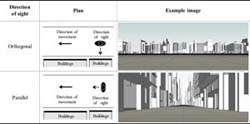 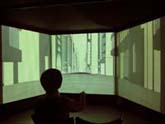 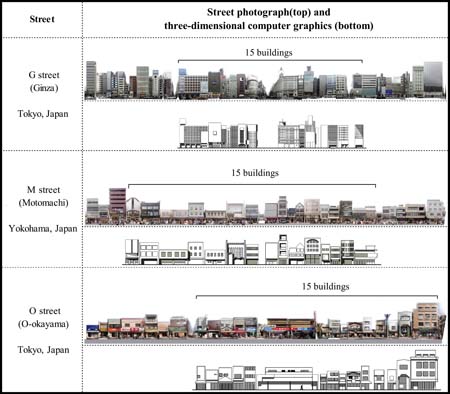 |
|
 The effects of acoustic environment on pedestrians’ anxiety on a night street
The effects of acoustic environment on pedestrians’ anxiety on a night street
|
|
<11th European Architectural Envisioning Association Conference, Envisioning Architecture: Design, Evaluation, Communication, pp. 153-160, Sep. 2013>
|
| Ryuzo Ohno, Tokuko Matsuda |
In urban areas people tend to stay out later at night, making it more important than ever to keep public spaces free from crime. Since many people, particularly women, often overestimate the risk of actually falling victim to crime, measures moreover need to be taken to make places feel safe in order to prevent limiting nighttime activity. As a step toward designing public spaces to feel safe and comfortable at night, the present study employs an audio-visual simulation laboratory to examine how acoustic conditions affect pedestrians’ sense of anxiety while walking along a night street.
For the study, virtual night streets were created inside an audio-visual simulation laboratory through images projected on a front screen and sounds transmitted over headphones. The 36 subjects were asked to imagine they were walking on the street to visit a friend’s house late at night. Three settings (a small local shopping street, a street along a city park, and a street in a residential neighborhood) were combined with 13 types of sound (such as footsteps, conversation, an automobile, a streetcar, police car sirens, and silence) for a total of 35 experimental situations. The subjects rated their degree of anxiety on a 7-grade scale from “very anxious” to “very much at ease”; the reasons for their responses were queried in a later interview.
Major findings were as follows. 1) The sound of a man’s footsteps from behind aroused the most anxiety. A woman’s footsteps, on the other hand, were rated positively particularly by female subjects, suggesting that the presence of other female pedestrians was a source of reassurance. 2) In another, even clearer illustration of the effect of natural surveillance, the sound of female conversation was also shown to make pedestrians feel safer. Male conversation aroused concern in some subjects, however. 3) Environmental sounds such as that of an unseen running train made some subjects feel more secure than total silence because the association with nearby human activity reduced their sense of isolation.
In all, the results illustrate that pedestrians on a night street associate acoustic information with various possible scenarios that may arouse or assuage anxiety. One useful way to provide assurance is to give indications of other, non-threatening pedestrians present along the same path.
|
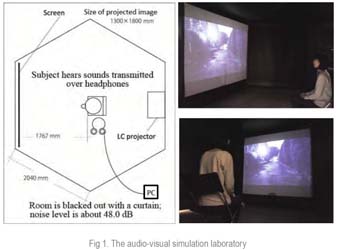
 |
Full paper → PDF (EAEA2013)
|
|
 A quasi-experiment on a space around a person walking with a trolley bag or baby stroller A quasi-experiment on a space around a person walking with a trolley bag or baby stroller
|
|
<Proceedings of the 44th Annual Conference of Environmental Design Research Association, p. 356, May. 2013.>
Ryuzo Ohno, Izumi Kaneko
|
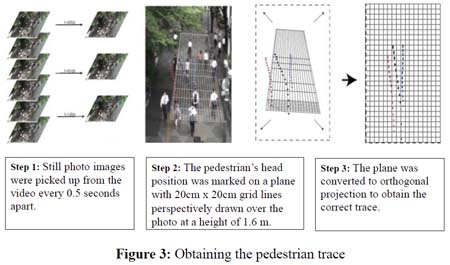 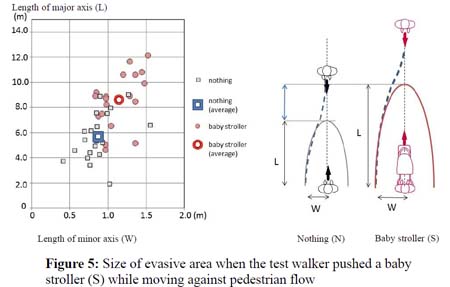 |
|
This study quantitatively examines the behavior of pedestrians moving close to a person with a trolley bag or baby stroller. The data will prove useful in estimating how much extra space needs to be allowed for those with such gear, for example in a railroad station or other transport facility. The experiment was conducted on a crowded street in a Tokyo business district during the morning commute. A male assistant hired for the experiment was asked to walk in three directions with respect to pedestrian flow—1) against, 2) along, and 3) across—while 1) carrying nothing, 2) pushing a baby stroller, 3) pulling a large trolley bag, or 4) pulling a small trolley bag, for a total of 12 experimental situations. The study revealed the following: 1) When moving against pedestrian flow, a walker pushing a baby stroller requires a 53% longer evasive space in the front than while carrying nothing. A 36% and 32% longer space is required for someone pulling a large and small trolley bag, respectively. 2) When moving along with pedestrian flow, a walker pulling a large bag requires a 62% longer evasive space in the back than while carrying nothing. 3) When moving across pedestrian flow, a walker pushing a baby stroller requires a 27% larger evasive space than while carrying nothing. Someone pulling a large or small trolley bag requires an 18% and 20% larger evasive space, respectively.
4) The above data can be used to estimate the extra room that needs to be allowed for people walking with a baby stroller or trolley bag in a public space. 5) A small trolley bag, which many pedestrians often seem not to notice, may carry greater risk of accident.
Paper → EDRA2013(poster)
|
|
 The Effects of Architectural Treatments on Reducing Oppressed Feelings Caused by High-rise Buildingst The Effects of Architectural Treatments on Reducing Oppressed Feelings Caused by High-rise Buildingst
|
|
<Proceedings of the Sixth Conference of the European Architectural Endoscopy Association, pp. 28-35, Sep. 2003>
|
| Masashi Soeda, Ryuzo Ohno, Jaeho Ryu, NaokiI Hashimoto, Makoto Sato |
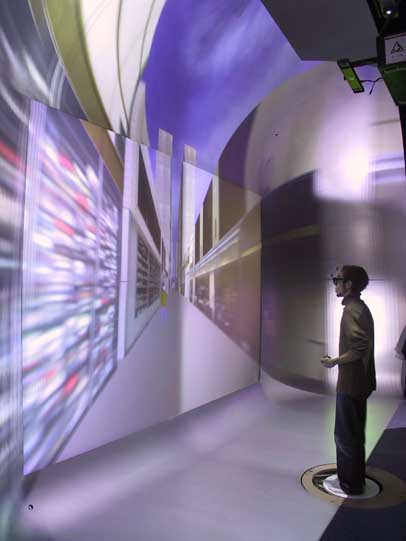 |
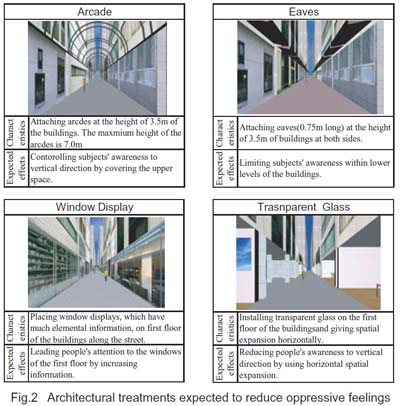 |
The authors conducted an experiment to examine the effectiveness
of architectural treatments in reducing oppressed feelings caused by high-rise
buildings along city streets. To create a virtual experience on the streets,
computer graphic images of the streets were projected on an immersive projection
display (6.3m x 4.0m) that moved according to the subject's walking pace
on the stepping sensor placed in front of the display. The results indicated
that installing transparent glass on the walls of buildings and arcading
significantly reduced oppressed feelings. The effectiveness of the treatments
was found to depend on the extent of the subjects' visual awareness.
Poster -> PDF |
|
 Street-scape and Way-finding Performance Street-scape and Way-finding Performance
|
|
<Proceedings of the 2nd EAEA Conference, pp. 111-120, Sep. 1995>
|
| Ryuzo Ohno, Koichi Sonoda, Masashi Soeda |
 |
The hypothesis that way-finding performance depends on the visual
characteristics of the street-scape was investigated by an experiment using
a user-controlled space-sequence simulator which was designed to allow
a subject to move through a model space and visually experience a travel
sequence.
Three scale models (1/150) of an identical maze pattern each with a different
street-scape were used in the simulator. The three types of street-scapes
were: (1) no characteristics, with monotonous surfaces, (2) each corner
distinguished with a different building, and (3) streets furnished with
trees, columns or fences.
Each subject was first asked to memorize the route by viewing a predetermined continuous sequence of model streets, as shown on the screen, then asked to take the instructed route. This procedure was repeated until a subject successfully reached the end of the route. Subjects were allowed to try up to five times. After the experiment, the subjects were asked draw a cognitive map of the route. Three male and three female subjects were tested in each of three street types.
An analysis of the results generally supported the hypothesis that a route in streets with significant visual characteristics was easier to memorize, although there was a large difference in performance between subjects. With an analysis of the cognitive maps drawn by the subjects, it was noted that subjects seemed to rely more on incoming visual information on the changing scene than on structured knowledge of the route, as is emphasized in conventional theory of way-finding.
Paper -> PDF |
|
goto TOP
|
|
|
|